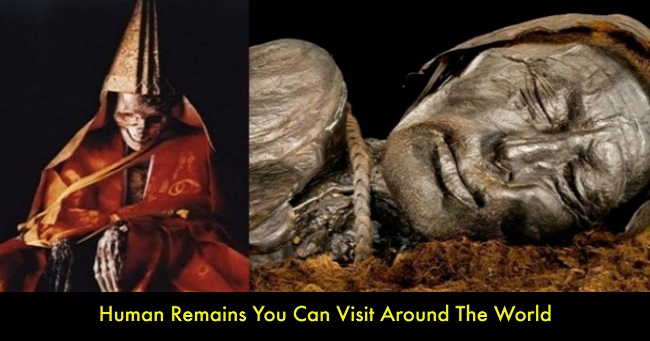


The world is full of bizarre places where you can find many interesting things. Such places are scattered all over the world and some of these places feature remains of famous people also. Here are 7 such places where you can see remains of human on public displays.
Ancient Egyptians used to mummify the bodies of royal pharaohs, priests, and even pets in order to provide the soul a safe passage in the afterlife. The British interest in the Egyptian mummies peaked when Howard Carter and Lord Carnarvon discovered the tomb of Tutenkhamen in 1922. Now the British wealthy people and museums hold the biggest collections of mummies outside Egypt.
Many museums in UK and other parts of the world like Manchester Museum, Metropolitan Museum of Art in New York, the Royal Ontario Museum in Toronto, the Louvre Museum in Paris, the Egyptian Museum and Papyrus Collection in Berlin have thousands of mummies displayed for visitors with important information.

Image Source: www.netdna-cdn.com
Sokushinbutsu literally means “self-mummification.” This ritual was performed by the Buddhist Monks from 1000-1800 AD in hope of their mortal being becoming a gateway between this world and spiritual world and these monks would achieve higher state of enlightenment.
The monks were buried alive under the ground under strict temperature regulations and the monk would die slowly, with body deprived of any nutrients so that bacteria wouldn’t harm the body. Such monks would be worshiped as gods or living Buddha. This practice was outlawed in Japan in 1877.
The last of such Sokushinbutsu monk was Tetsuryukai and his remains are available to visit at Nangaku Temple in Central Tsuruoka in northern Japan.
Image Source: www.24ur.com
The Sedlac Ossuary, Czech Republic is one of a kind church which was built in 1400s and displays skeletons of over 40000-70000 people. The bone decorations were added by Frantisek Rint in 1870. These bones were of the bodies of the people who wanted to be buried in the cemetery of the church.
The decorations have a chandelier made from bones of an entire body and a coat of arms for the Schwarzenberg family. The bones are arranged in skilled manner and artistically. The church administration believes that the church respects the wishes of the dead by allowing the bones to rest in peace near the holy soil.
Image Source: www.travelmint.com
Les Catacombes in France is a popular tourist place, which houses bodies and skeletons of people who were formerly buried in the Cemetery of the Innocents near Saint-Eustache in central Paris. These people were in the cemetery for 1000 years, before it was declared a health hazard and bodies were relocated. 6 million bodies were relocated from 1786-1860.
Now, these bodies are on display within the 200 miles of tunnels beneath the city. Some places are off limit to tourists and it is not socially acceptable to go without permission in those restricted places.
Image Source: www.ancient-origins.net
The Tollund Man is a bog body found in 1950 and is the best example to be ever to be discovered. The body was discovered with a rope around its neck, signaling a gory death for the poor soul. His last meal of porridge/oats was found in his intestines. The 30-year-old man died around 350 BC and he was found with hair and belt. The body is open to visitors in the Silkeborg Museum in Denmark.
Image Source: www.khoahocphattrien.vn
Vladimir Lennin was the first leader of Soviet Russia and was embalmed on his death according to his wishes. His body is on display in a mausoleum near the Kremlin in Red Square in Moscow since 1924. His body is well preserved and is religiously taken through a process of bathing, re-embalming and temperature control. There were no plans to keep his body for display for such a long time, but it has attracted so many visitors over the years, that government has decided to make it a permanent fixture.
Image Source: www.delmagyar.hu
The elephant man, whose real name was Joseph Merrick, was a Victorian man who suffered from Protheus syndrome, which has severely distorted his skeleton. He spent his time in a workhouse doing menial jobs for food and shelter and was picked up by a freak show company in 1884.
Despite hardships, he was rescued by Dr. Frederick Treves from London hospital and a public fund was setup to take care of his expenses. After his death, death masks and casts of his skeleton were made and skeleton was displayed. His skeleton is still in a glass case at the Royal London Hospital in Whitechapel.
However, only medical professionals or students can view the skeleton and it is not open for public viewing. Pictures of his skeleton were released by doctors to the public.
Image Source: www.bbci.co.uk